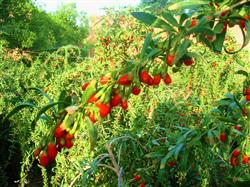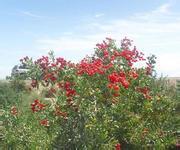Fertilization of Chinese wolfberry

The annual growth period of Lycium barbarum is long, and it goes through important phenological processes from mid-March to early November, such as flower bud differentiation, branch and leaf growth, flowering and fruiting, root growth and so on. Each process consumes a lot of nutrients, and some phenological phases overlap, such as branch and leaf growth, flower bud differentiation, flower bud and fruit growth at the same time. Therefore, it needs a lot of nutrients and a long period of fertilizer supply. if the nutrient supply is insufficient, the new branches will be short and weak, the flower bud differentiation will be affected, the number of flowers will be less, the falling flowers and fruit will be aggravated, and the fruit will be small. it will also affect the root growth and leaf photosynthesis, it will not only affect the current year's yield, but also directly affect the tree nutrient accumulation and the next year's growth. Fertilization is to constantly increase the nutrients in the soil, to create a good growth environment for Chinese wolfberry, so that it grows well, has many flowers and fruits, and has high yield. Types and periods of fertilization: in production, the types of fertilization are divided into base fertilizer and topdressing. The base fertilizer is mainly farm manure, supplemented by chemical fertilizer. Farm manure mainly includes sheep manure, cattle manure, oil dregs (cake) and human feces and urine. Farm manure can not only improve the soil and improve fertility, it is also a good complete fertilizer, can supply a variety of nutrients needed for the growth of Chinese wolfberry. The base fertilizer is well applied in autumn, and all the old producing areas of Chinese wolfberry have the habit of applying base fertilizer in October. If it is too late to apply base fertilizer in autumn, it should be applied early in the following spring, combined with some quick-acting fertilizer, so as to play the role of fertilizer effect as soon as possible. Topdressing is to increase the application of quick-acting fertilizer during the growth and fruiting period of Chinese wolfberry to make up for the lack of base fertilizer. It is mainly based on quick-acting fertilizer, supplemented by mature human feces and urine. For chemical fertilizers, nitrogen fertilizers include urea, ammonium sulfate, ammonium nitrate and ammonium bicarbonate; phosphate fertilizers include calcium superphosphate and heavy superphosphate; potassium fertilizers include potassium sulfate, potassium chloride and so on. In addition, there are nitrogen, phosphorus and potassium ternary compound fertilizer, ammonium phosphate and potassium dihydrogen phosphate binary compound fertilizer, which are good fertilizers for Chinese wolfberry. In the application of different nitrogen, phosphorus and potassium fertilizers, the total fertilizer yield of nitrogen, phosphorus and potassium was the highest, and the fruit grain was the largest, followed by nitrogen and potassium fertilizer area. The experiment shows that the application of potassium fertilizer on the basis of nitrogen and phosphorus fertilizer can promote the absorption of soil nutrients by Lycium barbarum trees, and the application of potassium fertilizer is also beneficial to the growth and development of trees. The potash fertilizer experiment also showed that it was necessary to supplement potash fertilizer from before the leaf germination of Chinese wolfberry to the end of fruit harvest. Chinese wolfberry trees need different fertilizers in different growth stages, which should mainly meet the needs of nitrogen for branch and leaf growth from budding to flowering. During the peak periods of flower bud differentiation, branch and leaf growth and fruit growth and development, the combined application of nitrogen, phosphorus and potassium fertilizer should be better. The period of topdressing should be determined according to the growth and fruit of the tree. The period from late April to early May is the period of new branch and leaf growth and flower bud formation of Lycium barbarum, which needs to be applied for the first time, mainly with urea and appropriate amount of phosphate fertilizer; from the beginning of June to the end of July is the peak period of a large number of new branch growth, bud formation and flowering and fruiting in a year, and it is also the peak period for the expansion and growth of a large number of fruits, which requires sufficient nitrogen, phosphorus and potassium fertilizer. If the fertilizer is insufficient, it will affect the growth and aggravate the drop of flowers and fruits. If there are many new branches of Chinese wolfberry in early August, and there are many buds, in order to promote the growth of autumn fruit, we should also pursue nitrogen, phosphorus and potassium fertilizer again at this time. In order to alleviate the contradiction of lack of nutrients in trees, foliar topdressing was carried out every 15 murals and 20 days during the peak period of flowers and fruits from the beginning of June, which played a good role in protecting flowers and fruits and increasing yield. Fertilizer application amount: the fertilizer application amount of Chinese wolfberry should be determined according to crown size, growth strength and soil properties. Generally speaking, the amount of fertilizer application is that big trees are more than small trees, weak trees are more than prosperous trees, trees with more fruit are more than trees with less fruit, and barren sandy land is more than deep and fertile loam. Due to the long growth and fruiting period of Chinese wolfberry in a year, the regular supply of sufficient fertilizer and water will be more conducive to growth, flowering and fruiting, and it is easy to get high and stable yield. Fertilization methods: the application of medlar base fertilizer can be divided into three kinds: ring ditch application, semi-ring ditch application and strip ditch application. After the fertilization ditch is dug, apply the base fertilizer, spread it evenly in the ditch, mix well with the soil, and then cover it with filling. Root topdressing is usually applied in holes or furrows, that is, under the edge of the crown, shovel 3-4 holes or on both sides of the crown. Dilu picked up Mei Chan ? Fertilizer ditch 0 cm deep, apply available nitrogen, potash fertilizer or nitrogen, phosphorus and potassium compound fertilizer, and then cover it. After fertilization, followed by irrigation, so that the root system to absorb fertilizer as soon as possible. Phosphate fertilizer (calcium superphosphate, bone meal, etc.) is easy to synthesize insoluble phosphates with iron and calcification in soil and is fixed in soil, which is not easy to be absorbed by roots. Therefore, phosphate fertilizer should be applied in time before Lycium barbarum needs fertilizer, or mixed with organic fertilizer, with the help of organic acid in organic fertilizer to increase its solubility and facilitate root absorption. Foliar topdressing is also called foliar spraying. This method is simple and easy, with less fertilizer and fast fertilizer effect. some fertilizers (urea, potassium dihydrogen phosphate, etc.) can be mixed with pesticides to save labor and reduce cost. The method of spraying fertilizer is to mix nitrogen, phosphorus and potassium fertilizers into 0.5% water extract and spray them on the crown. Foliar spraying time is best chosen in cloudy or sunny days before ll o'clock in the morning and after 4 o'clock in the afternoon, and do not spray in the hot sun at noon, in order to reduce foliar evaporation and facilitate foliar full absorption. It is not suitable to spray fertilizer on rainy days because of serious leaching.
- Prev

The adaptability of Lycium barbarum L. is easy to plant
Lycium barbarum has strong germination power, and many new branches are issued from April to August every year, and tillers grow from the roots. Lycium barbarum is cold-resistant, light-loving and saline-alkali tolerant. There are two kinds of reproduction: sexual reproduction and asexual reproduction. Sexual reproduction will be the fruit soaked in water for 1-2 days, softened after washing out the seeds dried. Sowing in late March, covering soil 1 cm...
- Next

Wonderful use and cultivation of Lycium barbarum
The key technical measures of high-yield cultivation are timely topdressing and extra-root fertilization, and reasonable watering (irrigation) according to different growth periods. Do a good job in shaping and pruning young trees, cultivate high-yielding trees, and timely adult pruning to promote the formation of fruit branches and fruit development. Strengthen the prevention and control of diseases and pests. It will open in the 4th year after harvesting Chinese wolfberry.
Related
- Fuxing push coffee new agricultural production and marketing class: lack of small-scale processing plants
- Jujube rice field leisure farm deep ploughing Yilan for five years to create a space for organic food and play
- Nongyu Farm-A trial of organic papaya for brave women with advanced technology
- Four points for attention in the prevention and control of diseases and insect pests of edible fungi
- How to add nutrient solution to Edible Fungi
- Is there any good way to control edible fungus mites?
- Open Inoculation Technology of Edible Fungi
- Is there any clever way to use fertilizer for edible fungus in winter?
- What agents are used to kill the pathogens of edible fungi in the mushroom shed?
- Rapid drying of Edible Fungi

